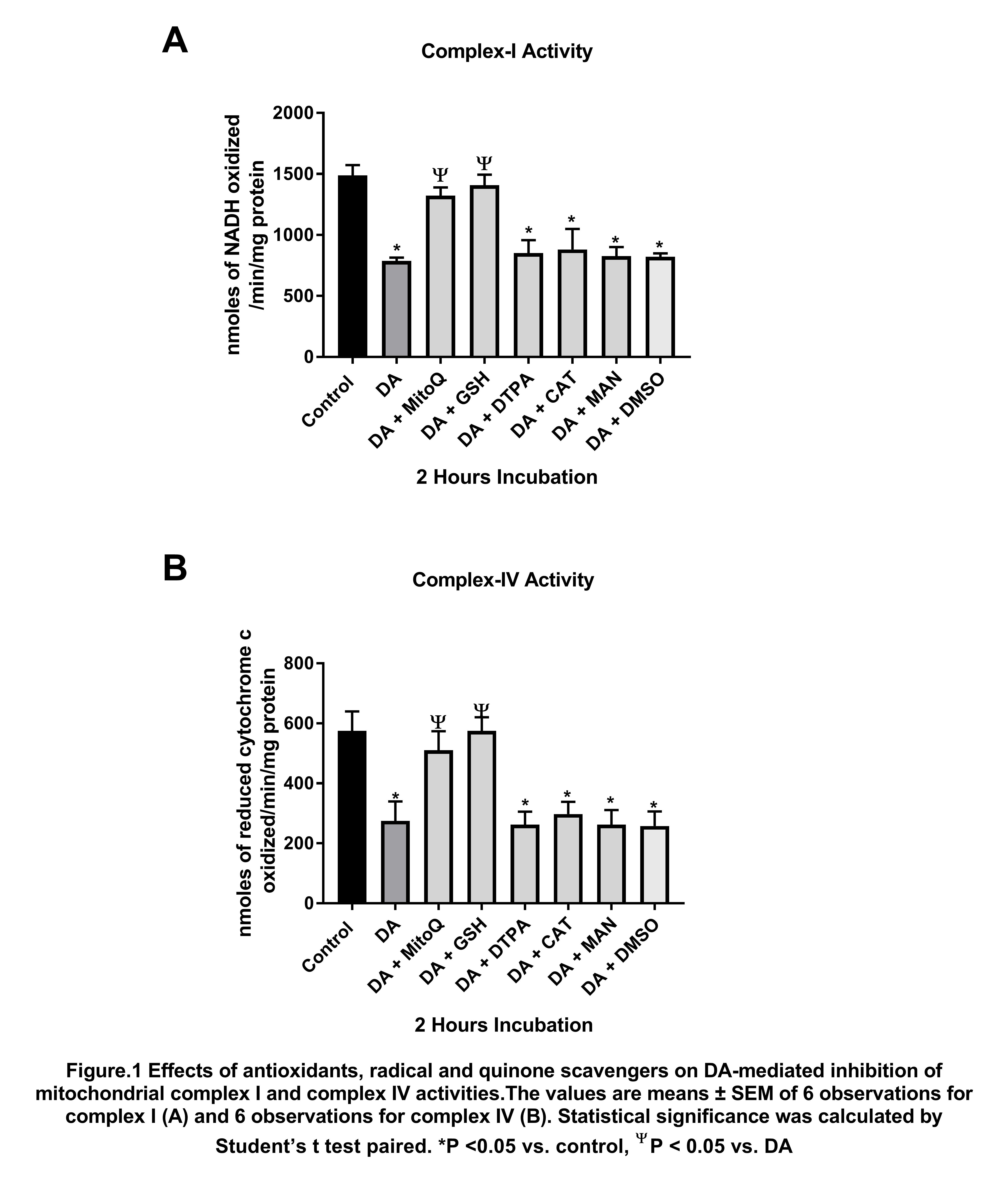Session Information
Date: Thursday, June 8, 2017
Session Title: Clinical Trials and Therapy in Movement Disorders
Session Time: 1:15pm-2:45pm
Location: Exhibit Hall C
Objective: To study the impact of MitoQ and GSH against DA induced rat brain mitochondrial electron transport chain inhibition during extended in vitro incubation.
Background: Studies on mitochondrial functions following extended exposure to dopamine (DA) in vitro have produced variable results. Our previous study suggests the predominant involvement of quinone products in long-term DA-mediated inactivation of complex I and IV(1). Reduced glutathione (GSH), a quinone scavenger, almost completely abolished the DA effect on mitochondrial complex I and IV activities, but was not prevented by catalase or metal-chelator diethylenetriaminepentaacetic acid (DTPA) or the hydroxyl radical scavengers like mannitol and dimethyl sulphoxide (DMSO) indicating the non-involvement of •OH radicals and Fenton’s chemistry in this process. In our current in vitro study, MitoQ, a mitochondria specific antioxidant (known for peroxynitrite and superoxide scavenging) has been included for the first time as there exists no previous data on such study.
Methods: Isolated rat brain mitochondria suspended in 50mM phosphate buffer, pH 7.4 (200µl containing 200µg protein) were incubated with varying concentrations of DA (100–400µM) for up to 2 hours with or without additions such as reduced glutathione (5mM), MitoQ (50nM), catalase (50µg/ml), mannitol (20mM), DMSO (20mM) at 37ºC in 50 mM phosphate buffer, pH 7.4 in a total volume of 400 µl. At the end of the incubation, the mitochondrial membranes were washed with an excess of ice-cold 50mM phosphate buffer, pH 7.4, collected by centrifugation at 4ºC and resuspended in the same buffer. Aliquots of mitochondrial suspension were used for measurement of complex I (Hatefi 1978) and complex IV (Wharton and Tzagoloff, 1967) activities.
Results: The inhibition of complex I and IV activities were prevented by reduced glutathione (5mM) and MitoQ (50nM), however, catalase, DTPA, mannitol and DMSO failed to provide protection (Figure1). These results indicate the contribution of DA-derived quinone products along with peroxynitrite (ONOO-) and superoxide (O2º-) in the inhibition of complex I and IV activities.
Conclusions: Quinone products and ONOO-/O2º- are involved in the long-term DA-mediated inactivation of complex I and complex IV
References: Khan et al. BBA (2005) 1741: 65-74
To cite this abstract in AMA style:
A. MAITI. MitoQ and Reduced Glutathione Protects Against Dopamine Induced Brain Mitochondrial Electron Transport Chain Inhibition During Extended In Vitro Incubation: Involvement of Free Radicals and Quinone Products [abstract]. Mov Disord. 2017; 32 (suppl 2). https://www.mdsabstracts.org/abstract/mitoq-and-reduced-glutathione-protects-against-dopamine-induced-brain-mitochondrial-electron-transport-chain-inhibition-during-extended-in-vitro-incubation-involvement-of-free-radicals-and-quinone-pr/. Accessed January 7, 2026.« Back to 2017 International Congress
MDS Abstracts - https://www.mdsabstracts.org/abstract/mitoq-and-reduced-glutathione-protects-against-dopamine-induced-brain-mitochondrial-electron-transport-chain-inhibition-during-extended-in-vitro-incubation-involvement-of-free-radicals-and-quinone-pr/

